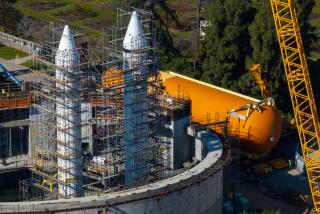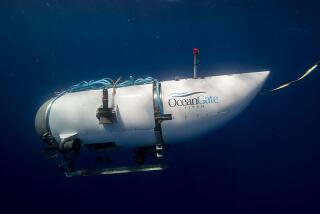Experts at NASA Join Probe of TWA Crash
- Share via
SMITHTOWN, N.Y. — Scientists at the Marshall Space Center in Huntsville, Ala., are joining the attempt to solve the 5-week-old mystery of what caused the crash of Trans World Airlines Flight 800 off Long Island.
Robert Francis, vice chairman of the National Transportation Safety Board, said Thursday that shattered components of the Boeing 747’s belly fuel-tank system are being flown to the space agency facility in the hope that “the same folks who worked on the Challenger” spacecraft crash investigation can help shed some light on the Flight 800 disaster.
Francis declined to speculate on what NASA’s examination of fuel pumps, probes that monitor the amount of fuel and other belly-tank debris recovered from the ocean bottom might reveal.
But he has said repeatedly that there is strong evidence of a fiery explosion in the tank, which underlies a portion of the passenger cabin directly ahead of the wings. That evidence includes bits of charred, twisted metal from the fuel tank area.
The tank was nearly empty when the jet took off from New York’s John F. Kennedy International Airport, but it still contained about 100 gallons of high-grade kerosene--enough jet fuel to generate volatile fumes that could have detonated in an explosive burst of flame.
The question is: What might have ignited those fumes?
Most investigators still favor the possibility that it was a small but powerful bomb, perhaps one placed under a passenger seat directly above the tank. A bomb placed beneath a seat exploded on an Avianca Colombian jetliner in 1989, triggering a blast in the belly fuel tank that felled the Boeing 727.
But other investigators are studying the possibility that some mechanical failure on Flight 800 could have touched off the fumes generated by the sloshing jet fuel.
“It only takes one little spark,” one source said.
Although Francis declined comment, it is believed that NASA experts are looking for some sort of malfunction in the fuel-pumping and monitoring system that could have generated that spark.
It had been hoped that analysis of a “loud sound” captured by the plane’s cockpit-voice recorder might have told investigators whether a bomb exploded, but experts say nothing conclusive has been found.
A third possibility--that a missile was fired at Flight 800--is still technically under consideration. However, because radar data fail to show the sort of track that would have been left by a missile, most investigators are skeptical of this theory.
Infrared sensing systems on the ground detected two separate blasts on July 17--the first as Flight 800 was climbing through 13,500 feet after takeoff from New York, the second one moments later, as the shattered aircraft plunged toward its final destination on the floor of the Atlantic Ocean, about 10 miles off the coast of Long Island. The crash killed all 230 on board.
Investigators now think the first blast may have been the exploding belly tank; the second a massive fireball that erupted when thousands of gallons of misting fuel from ruptured wing tanks burst into flame. Pilots of other planes in the area said the fireball ignited at about 9,000 feet.
The delay between the two blasts probably occurred because the wing-tank fuel had to vaporize sufficiently before it could ignite, investigators say.
By nightfall Thursday, Navy divers had largely completed their search of two of the three main debris fields on the ocean bottom.
Francis, however, said the remaining debris field still contains a “great deal of wreckage,” and the undersea recovery effort is expected to continue for weeks.
Thus far, the bodies of 209 of the victims have been recovered.
More to Read
Sign up for Essential California
The most important California stories and recommendations in your inbox every morning.
You may occasionally receive promotional content from the Los Angeles Times.













